Cancer treatments often cause nerve damage that can lead to long-lasting symptoms. Medication has proven ineffective in these cases. A sports scientist at the University of Basel, together with an interdisciplinary team from Germany, has now shown that simple exercises can prevent nerve damage.

Credit: University of Basel, Florian Moritz
Cancer treatments often cause nerve damage that can lead to long-lasting symptoms. Medication has proven ineffective in these cases. A sports scientist at the University of Basel, together with an interdisciplinary team from Germany, has now shown that simple exercises can prevent nerve damage.
Cancer therapies have improved over the years. It is no longer just about sheer survival: quality of life after recovery is gaining more importance.
Unfortunately, many cancer medications, from chemotherapy to modern immunotherapies, attack the nerves as well as the tumor cells. Some therapies, such as oxaliplatin or vinca alkaloids, leave 70 to 90 percent of patients complaining of pain, balance issues, or feelings of numbness, burning or tingling. These symptoms can be very debilitating. They can disappear following cancer treatment, but in around 50 percent they become chronic. Specialists call it chemotherapy-induced peripheral neuropathy, or CIPN for short.
A research team led by sports scientist Dr. Fiona Streckmann from the University of Basel and the German Sport University Cologne has now shown that specific exercise, concomitant to cancer therapy, can prevent nerve damage in many cases. The researchers have reported their findings in the journal JAMA Internal Medicine.
Exercise alongside chemo
The study involved 158 cancer patients, both male and female, who were receiving treatment either with oxaliplatin or vinca-alkaloids. The researchers divided the patients at random into three groups. The first was a control group, whose members received standard care. The other two groups completed exercise sessions twice a week for the duration of their chemotherapy, with each session lasting between 15 and 30 minutes. One of these groups carried out exercises that focused primarily on balancing on an increasingly unstable surface. The other group trained on a vibration plate.
Regular examinations over the next five years showed that in the control group around twice as many participants developed CIPN as in either of the exercise groups. In other words, the exercises undertaken alongside chemotherapy were able to reduce the incidence of nerve damage by 50 to 70 percent. In addition, they increased the patients’ subjectively perceived quality of life, made it less necessary to reduce their dose of cancer medications, and reduced mortality in the five years following chemotherapy.
The participants receiving vinca-alkaloids and performing sensorimotor training, had the largest benefit.
Ineffective medications
A lot of money has been invested over the years in reducing the incidence of CIPN, explains Streckmann. “This side effect has a direct influence on clinical treatment: for example, patients may not be able to receive the planned number of chemotherapy cycles that they actually need, the dosage of neurotoxic agents in the chemotherapy may have to be reduced, or their treatment may have to be terminated.”
Despite the investments made, there is no effective pharmacological treatment to date: various studies have shown that medications can neither prevent nor reverse this nerve damage. However, according to the latest estimates, USD 17,000 are spent per patient every year in the USA on treating nerve damage associated with chemotherapy. Streckmann’s assumption is that “doctors prescribe medications despite everything, because patients’ level of suffering is so high.”
Study ongoing in children’s hospitals
In contrast, the sports scientist emphasizes, the positive effect of exercise has been substantiated, and this treatment is very cheap in comparison. At the moment she and her team are working on guidelines for hospitals, so that they can integrate the exercises into clinical practice as supportive therapy. In addition, since 2023 a study has been ongoing in six children’s hospitals in Germany and Switzerland (PrepAIR), which is intended prevent sensory and motor dysfunctions in children receiving neurotoxic chemotherapy.
“The potential of physical activity is hugely underestimated,” says Fiona Streckmann. She very much hopes that the results of the newly published study will lead to more sports therapists being employed in hospitals, in order to better exploit this potential.
Journal
JAMA Internal Medicine
Method of Research
Randomized controlled/clinical trial
Article Title
Prevention of chemotherapy-induced neuropathy with specific exercises concomitant to therapy – a multi-centre, randomized, controlled trial (STOP)
Article Publication Date
1-Jul-2024



